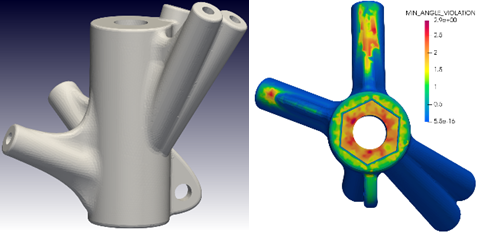Research Summary Report C02
3D Structural Puzzle – Numerical Multi Scale Shape and Topology Optimisation Methods to Additively Manufacture Optimal Structures from Optimised Pieces
[27.01.2022]
Bletzinger, Kai-Uwe: Project Leader
Najian Asl, Reza: Post-Doc Research Associate
TU Munich, Chair of Structural Analysis
Summary
This project deals with structures considered as large 3D puzzles and multi scale optimization aspects. The goal is to create optimized individual structural pieces which are subsequently assembled to form an overall optimal structure. Additive manufacturing is the ideal meaning of greatest potential to combine industrial efficient production with individual design and structural layout. The main research question is to develop numerical, simulation-based optimization methods which allow for the design and creation of large, additively manufactured structures to be carried out as a consistent, holistic procedure. Based on Vertex Morphing for free-form shape optimization, numerical methods for supporting a complete simulation based multi scale optimization tool chain will be developed. It will span from:
- The first tentative form finding of the large, complete structure (large scale).
- Further detailed structural design and optimization (large scale), through the optimal decomposition into structural pieces.
- The optimized design of those pieces considering compensation and residual stresses as consequences of the composition procedure (medium scale).
- As well as specifications and constraints of the printing process (small scale).
The joint potential of simulation, optimization, and additive manufacturing will be exploited for structures of innovative shapes.
Current state of research
Since we aim at treating the aspects of optimisation on the large scale of the structure and the interaction with the optimisation on the smaller scale of the pieces, we have developed, implemented and tested more sophisticated filter scheme for Vertex Morphing, including design appropriate boundary conditions. The new filtering scheme provides a computationally more efficient and tractable way of implementing the standard filtering scheme, i.e. explicit filtering.
Our main aims are threefold: (i) avoid storing large arrays of neighborhood information to ensure efficient computations on large-scale problems, (ii) circumvent problems of the traditional filter concerning strong enforcement of Dirichlet boundary conditions, and (iii) construct well-conditioned filtering matrix and optimization problem respectively.
Furthermore, we have formulated and then included hangover conditions for the additive manufacturing of Laser Powder Bed Fusion (LPBF) of steel elements in gradient-based shape optimization. We formulate hangover conditions by imposing the minimal overhang angle on the boundary shape. We cast these constraints into the form of Heaviside projection based integral, which is continuously differentiable.
Recent developments were tested on a node (Figure 1) of a tensegrity-tower, which is designed and realized by the Technical University of Munich and was built at the Deutsches Museum in Munich in 2021. The node is made of aluminium and manufactured using laser powder bed fusion of metals (PBF-LB/M/AlSi10Mg). Node-based shape optimization was performed to reduce the mass and the required support structure in 3D-printing process, without sacrificing the structural properties of the node. The optimized shape and the distribution of the regions requiring support are represented at Figure 2.
The optimized node has 20% less mass and requires 36% less support structure. It should be mentioned that the bottom of the node was not subject to shape change. We would like to point out that the new scheme has much better conditioning and numerical properties compared to the standard explicit one.











